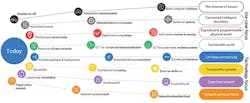Getting to the Next G
5G and Beyond —
As the ICT industry evolves from 5G to Next G, there are many exciting use cases on the horizon. (See Figure 4-4.) While each is subject to change as the industry and consumers’ future needs are better understood, the possibilities are impressive. Just a few of them include:
Figure 4-4. 6G Technology Journeys (Provided by Ericsson from 6G Symposium, October 2020. Used with Permission.)
1. Holographic Communications
Holography is a method of producing a 3D image of a physical object by recording, on a light-sensitive medium (e.g., photographic plate), the pattern of interference formed by a split laser beam where one of the beam paths interacts with the 3D object in question. The resulting interference pattern contains the complete optical amplitude (intensity), phase (depth) and wavelength (color) information that characterize a visual representation of any 3D object formed by the human brain. When the interference pattern is illuminated either with a laser or with ordinary light, the optical amplitude and phase information of the original object is regenerated, and the human brain perceives a realistic 3D picture of the original object.
Studies based on human perception of 2D images and conventional 3D videos that use binocular parallax technology to create 3D effect and holograms reveal that a holographic display comes closest to satisfying all visual cues for human visual observation of any 3D object. In other words, for humans, true holograms are the best substitutes for natural sight.
In the next decade, network advancements are expected to enable fully immersive user experiences virtually. A key component of the immersive nature of user experience is the transmission of 3D holographic images from one/multiple sources to one/multiple endpoints in an interactive manner. There are a variety of user-device-oriented technologies, such as the adoption of lenslet light-field 3D through the naked-eye, or AR/VR via head-mounted display (HMD) devices. However, fully immersive, and interactive 3D holographic imaging/streaming, will be a challenge even for future networks.
2. Tactile/Haptic Communications
The Tactile Internet can be considered as the next evolution of the Internet of Things (IoT). The Tactile Internet encompasses human-to- machine and machine-to-machine interaction, enabling a variety of real-time interactive and control systems applicable to industrial, societal, and business use cases. It adds a new dimension to human-to-machine interaction by enabling transmission of human touch and haptic sensations. This enables humans and machines to interact with their environment, while on the move and within a certain physical range over which communication takes place.
Robotic surgery is one example of the Tactile Internet. At one end is the human system interface, which is a master console where the surgeon gets a real-time audio-visual-haptic feed of the patient and operating room. Additional data feeds such as patient diagnostics and reactions are provided in real time. The visual feed is provided using real-time holographic streaming technology (mentioned above) with adjustments based on whether the surgeon is wearing a head-mounted display device or interacting with a hologram. As the surgeon proceeds with the operation the haptic-enabled robots (Human System Interface) at the patient-end mimics the surgeon’s actions with high reliability, fidelity, and minimum latency. Real-time feedback (audio/visual/haptic/patient diagnostic) from the patient side is transmitted back to the surgeon throughout the surgery process.
The Tactile Internet use cases generally comprise real-time interactions that require the network to have very low end-to-end latency and guaranteed high bandwidth support. True interactive control in the Tactile Internet requires stringent synchronization between various data feeds. These network requirements will be explored in a later section.
InvisiLight® Solution for Deploying Fiber
April 2, 2022Go to Market Faster. Speed up Network Deployment
April 2, 2022Episode 10: Fiber Optic Closure Specs Explained…
April 1, 2022Food for Thought from Our 2022 ICT Visionaries
April 1, 20223. Ubiquitous Services (Land, Air, Space, Sea)
This use case provides seamless service coverage nearly everywhere: all terrestrial, marine, air, and space-based locations. A seamlessly integrated connectivity framework consisting of land, sea, air, and space-based nodes would be a significant step forward compared to today’s fragmented scenario.
A simple but powerful example is the ability to extend real-time emergency visibility and response to every remote corner of the world that until now were entirely cut-off from current emergency response infrastructure.
4. Medical/Health Vertical
A transformative healthcare experience in the 21st Century will need the confluence of multiple innovations spanning across all aspects of the healthcare industry. In addition, for telemedicine, especially for remote telesurgery performed by either human and/or robots, the underlying data transport must satisfy stringent and demanding requirements for reliability, fault tolerance, bandwidth, latency, jitter, and embedded AI. While 5G could meet some of these requirements, Next G is expected to be the first communication infrastructure capable of handling full spectrum healthcare needs of the 21st Century.
5. Government / National Security
Mobile networks are also becoming part of a critical national security strategy where governments see a need for advanced communication technologies and ubiquitous connectivity to operate with speed, precision, and efficiency.
National security requirements for future networks call for ubiquitous high-speed connectivity for moving massive amounts of data in dense networks and for low-latency communications to enable new generations of unmanned and autonomous systems, both in the air and on the ground.
Effective and survivable future networks must operate in contested environments with constant threats and counter with new capabilities. Spectrum-sensing systems will classify signals to detect denial-of-service attacks, and self-organizing radio access networks will dynamically use the spectrum to continue operations unimpeded. Future networks must counter attacks on data traffic, and control elements with national security-specific enhancements not found in commercial networks today, including robust network protocols and air interfaces with low-probability of intercept and detection.
Technology Enablers
The key is HOW to evolve the networks to meet the high-performance network needs of these use cases. Thankfully, many technology enablers exist today, and new ones are being developed to help fulfill the vision of Next G and beyond. Four (4) of these are briefly described below:
1. Artificial Intelligence (A.I.) at the Network Edge
As AI turns out to be an important resource to enable more powerful services across several use case categories, the necessity of AI at the edge of the network is becoming clearer.
For many use case categories, whether they support millions of low bandwidth devices on a massive IoT network, or networks with high bandwidth devices such as video cameras, enormous data sets will be created at the edge of networks. Reducing the need to transport these data sets to a central location requires intelligent processing at the edge. AI can be used to extract useful patterns and events out of a sea of raw data. For example, smart farming applications can spot dry patches or insect infestations, while a video surveillance system can pinpoint areas with suspicious looking activity.
2. A.I./ML in the RAN
AI/ML concepts and technology can be expected to have major impact on RAN systems evolution. Due to better level of performance and reduced complexity, they have the potential to replace some of the model-based Layer 1 and Layer 2 algorithms such as channel estimation, preamble detection, equalization, and user scheduling. AI/ML will be applied extensively in deployment optimization on the road towards zero human touch network optimization — for example, for configuring an optimal subset of beams with which to illuminate the coverage area, taking cell traffic patterns into account.
However, Next G systems can be envisioned to employ AI/ML in a more fundamental way — namely AI as a foundation for air interface design and optimization. Next G communication framework will be designed in such a way as to allow learning in the field to make some design choices. Through extensive training, a single deep-learning network at the transmitter and one at the receiver learn to pick the best design. This will enable optimization of the air interface characteristics based on the choice of spectrum, environment, hardware deployed and target requirements.
3. Fully Service-Based: Cloud Native Networking and RAN-Core Convergence
In the 5G era, the transition to a cloud-native and microservice-based architecture is a key change. Cloud-native technologies empower service providers and vendors to build and operate scalable applications in dynamic cloud environments. A microservice provides a dedicated business function and is an integral part of a service-oriented architecture with published APIs and options for discovery.
Beyond 5G networks are likely to be extreme-edge or edge centric and data flow-based across the network. Network functions and other workloads would be dynamically scheduled in a hierarchy of data centers across the network topology. The criteria used to arrange the functions and workloads would be based on the combination of available resources, connectivity needs, latency requirements, energy consumption targets, etc., and would use AI and ML-based multi-object optimization algorithms to optimally balance the criteria.
One of the most important dimensions of cloud-native architectures is how they are delivered and orchestrated: the transition to the DevOps paradigm will assure an agile framework for continuous delivery and integration for large scale digital production environments.
Research into the design options of the Next G offers the opportunity to make the network simpler and more flexible. Latency, security, resilience, and energy efficiency can be used as criteria to optimize functional placement. Separation of user plane and control plane, virtualization and cloud native implementation of the core have facilitated the greatly increased level of flexibility.
4. mmWave and THz Radio Technologies
Academia and industry are driving research into existing mmWave as well as greenfield and unexplored THz spectrum to meet world-wide demand for mobile communications and applications. At these new frequencies lie an opportunity for a tenfold increase in the amount of spectrum available today.
There is also a great opportunity for semi-autonomous Next G sub-networks with special attributes of performance, where at least the most critical services in the subnetwork will continue uninterrupted despite poor or no connectivity to the wider network.
Multiple path connectivity employing infrastructure and opportunistic device-to-device connections will be required for the ultra-reliability, potentially leading to fully meshed and truly cell-less architectures. The integration of such sub-networks into Next G architectural paradigm will ensure high data rates, extreme low latency, reliability, and resilience, while security and resilience features will be enforced to the lowest level of devices in the sub-network. Next G service execution can dynamically be split between execution in the edge cloud or in the device that is part of the sub-network.
The capabilities of this extended spectrum goes beyond today’s 5G capabilities, and enables even more new Next G use cases. The immense bandwidth available in the mmWave and THz regions add orders of magnitude higher data rates for terabit/sec mobile communications and backhaul systems. (See Figure 5-2.)
Figure 5-2. Spectrum Usage by Wireless Cellular Generation
But getting into this greenfield spectrum requires many beyond-leading-edge capabilities that make Next G radio technology uniquely distinct from earlier generations. The challenges span the mmWave/THz air interface and the transport and processing of signals at terabit/sec speeds.
While basic research is under way for the future of 5G and beyond, the R&D community today is squaring up to tackle the technical challenges to evolve 5G mmWave, sub-THz, and densified networks.
What’s Needed Now
Clearly, there is much work to be done to get from 5G today to the Next G. From a leadership standpoint, 5G Americas feels that North American wireless cellular and ICT companies should take the initiative instead of allowing other countries, regions, and organizations, to take the lead.
Our organization believes, in particular, North American technology companies, can do more to actively commit resources to push this work, and to lead and participate in these global organizations in order to support them and continue to drive an innovative vision. 5G Americas believes there may always be situations when companies may not agree. However, having common goals and visions will be helpful to ensure the viability of next-generation wireless networking.
This article is adapted from the white paper Mobile Communications Beyond 2020: The Evolution Towards the Next G by 5G Americas. The complete white paper, citations, and sources, can be found in this link: https://www.5gamericas.org/mobile-communications-beyond-2020-the-evolution-of-5g-towards-next-g/
For more information, email [email protected] or visit https://www.5gamericas.org/. Follow 5G Americas on Twitter @5GAmericas.
Like this Article?
Subscribe to ISE magazine and start receiving your FREE monthly copy today!
About the Author







